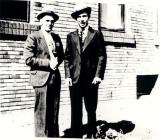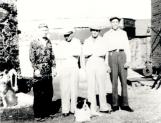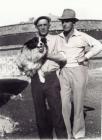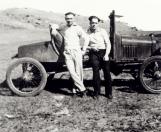1
Welcome to theBill Wallace story
2
Bill Wallace (l) and Joe Vierling (r) in front of the Claybank Brick Plant Bunkhouse in 19351935
Claybank Brick Plant Site

3
BILL WALLACE STORY(photo: Bill Wallce on the left)
In the late summer of 1932 I started working at the Brick Plant and worked until they shut down for the winter. I didn't get recalled to work until late summer of 1933 and worked again until shut down. The only employees that worked during the winter months were the senior married men and only when they were called in to load shipments of brick into boxcars or other necessary jobs. In the following years I worked fairly steadily from Spring start up to Fall shut down.
I worked at almost every job the Plant offered over the years. I loaded fire clay from the Dry Pans by wheel barrow into box cars. The wheel barrows at that time weren't balanced and by the end of the shift my arms felt like they were below my knees. Eventually the wheelbarrows were balanced but they still had steel wheels and we pushed them along a steel pathway, if you let the wheel slip or caught an edge the load would upset and you would have to reload it and continue on. It took me a couple of days of wheeling in order to become accustom to the technique, but I still upset the odd load. It was a source of amusement to watch new men starting to wheel bricks. Eventually a solid rubber tire replaced the steel wheel, this made the job a lot easier.
I helped load clay into dump cars from the pits south of the Site. The dump cars full of clay were hauled by a small Fordson tractor converted to run on a narrow gauge railway back to the storage shed at the Plant. I spent one summer as a clay loader man at the Blue Hills pit, I would load the trucks from an overhead chute built into a hill. I helped load boxcars with brick and blocks and also unload carloads of coal. It took two men over four hours to unload a forty ton car, that was a dirty job. I also helped haul coal to various places around the Plant and hauled ashes away to the dump. I helped haul dobie brick to the Grinder and squared brick in the grinding room, that was a dusty job so we wore masks most of the time.
I worked on a Ball Mill machine in the Hand Mould shop, this pulverized clay into a fine powder that was shipped out in small drums. I also helped with maintenance in the Engine Room and during the Spring start up. I finally got on to a crew that loaded kilns with green brick and unloaded them after firing. I also helped the firemen when the kilns were at high fire, that was a hot job especially in the summer. The Plant ran 10 hours a day, six days a week. It was a job and we were lucky to have work in those days.
I eventually started as a regular fireman the last few years I worked at the Plant. I would fire kilns and look after the boiler too. A fireman worked seven days a week, twelve hours a day for two weeks and then switched to the night shift. I lived in the Bunk House all those years until 1940 when I married and then lived in Claybank for two years. In July of 1942 I was called to serve in the Air Force.
I didn't mind working at the Brick Plant although it was hard work at times but I met a lot of good people there. As times were changing, I decided it was time to move on.
4
L to R: Joe Veirling, Dan Bednard, Bill Wallace, and Jim McColeman, 19361930
Claybank Brick Plant Site


